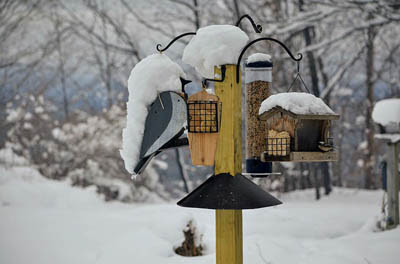Last Updated on January 20, 2024 by Greg Gillson
Are you thinking about setting up a bird feeder this winter in Maryland?
Are you looking for new ideas on feeders and foods to attract the winter birds in your backyard?
Do you want to know what the most common wild birds are at your feeder in Maryland during the winter?
Well, then, welcome–this article is for you!
This article tells why and how to set up a bird feeder in Maryland in the winter. I’ll also show you photos of the common feeder birds in Maryland that you can look for at your own backyard feeder! I will give brief identification tips. I will tell you what foods and what type of feeders attract each species.
The weather in Maryland is strongly influenced by the ocean. Nevertheless, winters are described as “severely cold and snowy.” Inland, winter lasts from December through February.
Snowfall ranges from 5 inches to 15 inches on the eastern shore, to 30 to 40 inches in the western highlands. It may snow any day between September and May, depending upon elevation.
All that cold winter weather means that birds will be hungry and seeking shelter and a meal in your yard!
Why feed winter birds in Maryland?
Maryland is on the Atlantic flyway, a migration route for many birds between Canada and the warmer states. Not all birds migrate all the way south to warm winter states or tropical islands of the Caribbean.
Many northern breeding birds spend the winter in Maryland.
And Maryland has many resident birds that visit bird feeders year-round.
The birds that visit your feeder in winter will include a majority of young birds. They hatched in spring only a few months before winter arrives. These inexperienced birds are especially grateful to find your bird feeder and the bounty of easy-to-find food.
Of course, birds do not absolutely depend upon humans for their winter survival.
One of the best reasons to feed birds is that they give us a connection to nature that we all need.
Nature provides us comfort and some peace of mind in a hectic and stressful world. Birds give us joy during the long Maryland winter. They provide a touch of color and entertainment to our day.
What birds come to feeders in winter in Maryland?
Many people feed birds without knowing their names. There’s nothing wrong with that.
But knowing the names of the most common backyard birds can make feeding birds more personal.
And, once you can tell a few of them apart, you’ll soon notice that while some birds are there every day, others only appear at certain seasons, and still others are very rare in your backyard.
I have written a companion article on the common backyard birds of Maryland, all through the year. You can check that article to see some birds in your yard at other times of year. Some of them don’t come to feeders. I’ll leave another link to that resource at the end of this article so you can check it out.
And if you find that you are even more interested than you first thought in feeding and identifying birds, I also provide a list of articles at the end of this one to start you on your journey.
Following, then, are the most common winter birds that come to feeders in Maryland.
Northern Cardinal
These are well-known birds due to their bright red coloration, fairly large size, and perky crest.
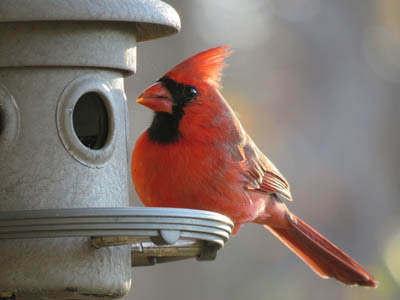 |
| Northern Cardinal. GeorgeB2 from Pixabay. |
These are year-round residents throughout the East and South.
Northern Cardinals are year-round residents throughout Maryland.
Larger than sparrows, but smaller than robins. Males are bright red, females brown. They have thick orange bills, black chin and throat, and obvious crests.
Northern Cardinals eat larger seeds, including sunflower seeds and safflower seeds from hopper and platform feeders, but often feed on the ground.
White-throated Sparrow
These birds are fairly common in the East in winter, rather rare throughout the West.
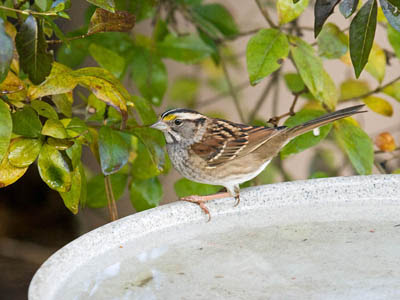 |
| White-throated Sparrow. Greg Gillson. |
These birds breed in Canada and northeastern United States. In winter they occur in the eastern and southern U.S.
White-throated Sparrows are winter visitors throughout Maryland.
These fairly large brown and gray sparrows have a striped head. The head striping can be gray and tan or black and white. The obvious white throat is bordered on the sides with throat stripes and contrasts strongly with the gray breast.
White-throated Sparrows eat smaller seeds such as white proso millet found in better mixed seed brands. They prefer to eat on the ground or platform feeders, but will also use hopper feeders.
Carolina Chickadee
This cute little bird is widespread throughout the southeastern United States in deciduous forests.
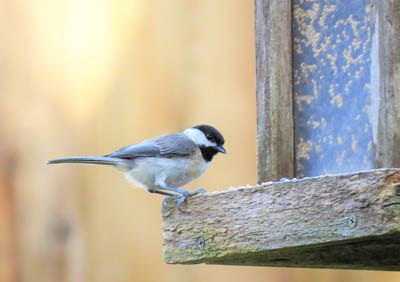 |
| Carolina Chickadee Image by George2 from Pixabay |
It is found in backyards and woodlands.
Carolina Chickadees are year-round residents throughout most of Maryland, except absent in the extreme western part of the state.
It gives a rapid chick-a-dee-dee-dee call and a whistled song fee-bee, fee-bay.
Gray back, wings, tail, and pale gray flanks. Black cap and throat contrasting with white face.Carolina Chickadees like seeds, especially black oil sunflower seeds. They like suet, too. They eat from any kind of feeder.
Carolina Wren
This wren is a common resident in woodland tangles and backyards throughout the East.
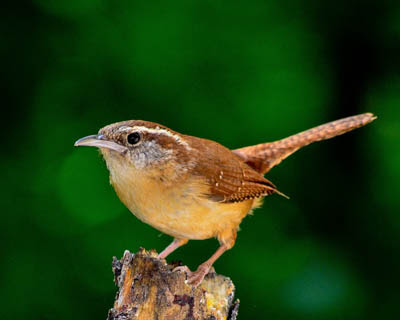 |
| Carolina Wren Image by SOARnet from Pixabay |
Carolina Wrens are year-round residents throughout Maryland.
Its breeding range expands and contracts following mild or harsh winters.
They sing all year, a loud musical teakettle, teakettle, teakettle or cheery cheery cheery. The call notes are loud and varied, including a chert call.
These have typical round wren bodies with short neck and long active tails. They are rich brown above, warm buffy below with a white throat and long white eyebrow strip back from the eye.
Carolina Wrens visit suet feeders.
Tufted Titmouse
These plain birds are rather common at bird feeders in the East.
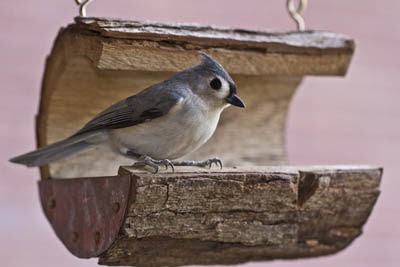 |
| Tufted Titmouse. Anne773 from Pixabay. |
These birds live year-round in deciduous woods east of the Great Plains in the United States.
Tufted Titmouses live year-round throughout Maryland.
Small, a bit larger than chickadees. They are plain gray with a bit of black feathers on their forehead. The crest is often inconspicuous.
Tufted Titmouses eat black oil sunflower seeds from hopper feeders. They are also fond of peanuts.
Blue Jay
These are well-known birds, displayed in advertising and sports teams.
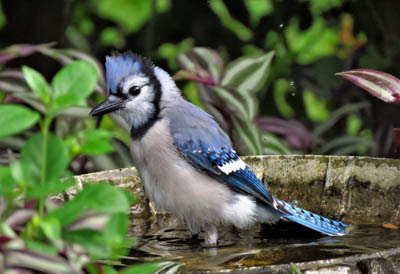 |
| Blue Jay. Skeeze from Pixabay. |
They live year-round in deciduous woods with oaks or nuts through most of the United States east of the Rocky Mountains. In summer they also migrate north well into Canada.
Blue Jays are year-round residents throughout Maryland.
These are blue above, white below and on the face, with a black necklace across the throat wrapping behind the head. The blue crest is a distinguishing mark.
Blue Jays eat sunflower seeds. They love peanuts, too. They use hopper and platform feeders.
Downy Woodpecker
This small woodpecker is widespread in North America and fairly common at bird feeders in winter.
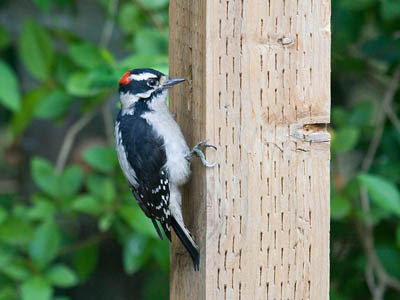 |
| Downy Woodpecker. Greg Gillson. |
Year-round residents from Alaska and across Canada south through the United States, but absent from the Desert Southwest.
Downy Woodpeckers are year-round residents throughout Maryland.
These are less than 7 inches long, bill tip to tail tip. They have a black and white striped head, white back, and black wings with white spots.
Downy Woodpeckers love suet from suet feeders. They also eat hulled sunflower seeds.
Red-bellied Woodpecker
These woodpeckers are fairly common at bird feeders in the East, especially where there are larger hardwood trees.
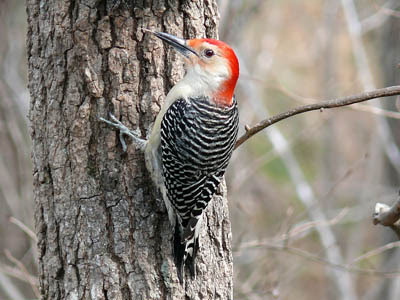 |
| Red-bellied Woodpecker. Skeeze from Pixabay. |
These birds live year-round in the United States east of the Rocky Mountains and Great Plains.
Red-bellied Woodpeckers live year-round throughout Maryland.
These birds cling to tree trunks. They have finely barred black-and-white backs. The head and under parts are rather pale gray. Red feathers on the back of the neck reach the bill on males.
Red-bellied Woodpeckers love peanuts from platform feeders. They also eat sunflower seeds and suet.
Song Sparrow
This is a common wetland bird across North America that also hides out in backyards with large bushes and hedges.
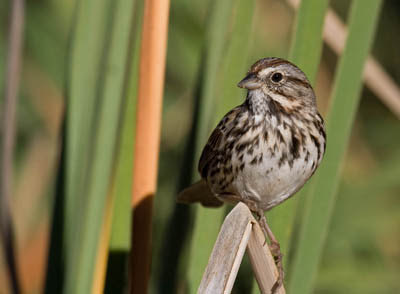 |
| Song Sparrow Photo by Greg Gillson |
Song Sparrows are year-round residents throughout Maryland.
It forages and hops on the ground where its heavy dark brown streaking provides camouflage in the shadows.
It has a a trilled song that starts with two burry notes and a buzz. Its call sounds like chimp.
Song Sparrows will eat mixed seeds and black oil sunflower seeds from a hopper or platform feeder.
Mourning Dove
These birds are one of the most widespread in North America.
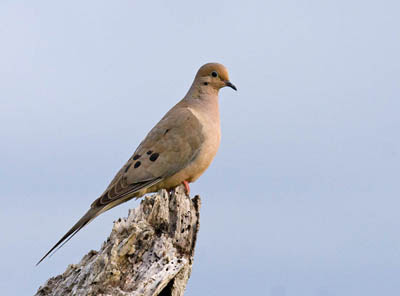 |
| Mourning Dove. Greg Gillson. |
In summer they breed in open fields, farms, prairies, towns, across all of the United States and north into Canada. In winter they depart most of Canada and the northern Great Plains and higher elevations in the northern states.
Mourning Doves are year-round residents throughout Maryland.
These plump birds have a small round head and pointed tail. They are larger than most feeder birds, but not as large as a domestic pigeon.
Mourning Doves eat mixed seeds and grains. They prefer eating on the ground or from platform feeders.
White-breasted Nuthatch
Nuthatches are active birds that crawl around branches and even head-first down tree trunks!
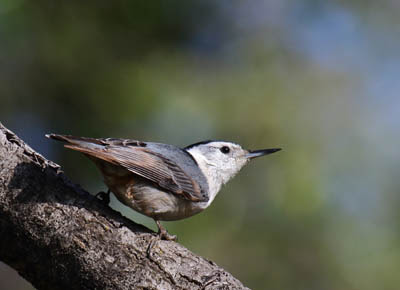 |
| White-breasted Nuthatch. Greg Gillson. |
These are widespread year-round birds across southern Canada and much of the United States. They avoid grasslands and deserts.
White-breasted Nuthatches are year-round residents throughout Maryland.
These are small chunk birds with large heads with long pointed bill and very short tails. These are gray above with black hind neck and crown. The face and under parts are white. They have a bit of rusty coloration on the flanks.
White-breasted Nuthatches eat black oil sunflower seeds from tube and hopper feeders and are fond of peanuts and suet, too.
American Goldfinch
This bright yellow-and-black bird is a favorite summer bird. However, many people don’t recognize these birds at their feeders in their dull brown winter plumage.
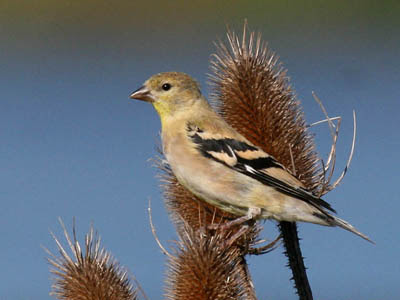 |
| American Goldfinch. Greg Gillson. |
Year-round residents across the northern half of the United States. In summer birds breed north well into Canada. In winter they move south throughout most of the U.S.
American Goldfinches are year-round residents throughout Maryland.
These are tiny birds with short forked black tails. Wings are black. Winter birds are dull brownish. In summer females are green while males are brilliant lemon yellow with black cap.
American Goldfinches eat black oil sunflower seeds from tube feeders. They love Niger seed from thistle feeders.
House Finch
These are one of the most widespread feeder birds in the United States.
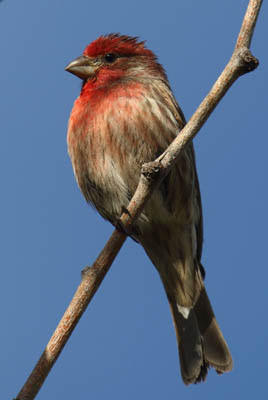 |
| House Finch. Greg Gillson. |
These birds are resident in towns throughout the United States, barely into southern Canada.
House Finches are year-round residents throughout Maryland.
Both males and females are rather dusty brown, heavily streaked on the chest. Only the males have red feathers on forehead, breast, and rump.
House Finches love to eat black oil sunflower seeds in the shell. They like tube feeders best.
Northern Mockingbird
These birds are common in backyards and brushlands.
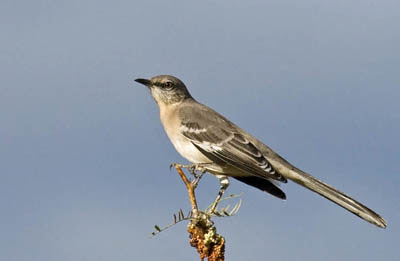 |
| Northern Mockingbird Photo by Greg Gillson |
They are found throughout the southern and eastern United States. They are residents in many areas, migrate in and out of the northern parts of their range.
Northern Mockingbirds are year-round residents throughout Maryland.
They are slim and gray with a fairly long pointed bill. They have white wing patches, exposed in flight. They have white outer tail feathers. They sing nearly throughout the year, often at night.
Their song is three notes or phrases repeated, then move on to another set of three. They have a huge repertoire and include mimicking other bird’s calls and mechanical noises.
Northern Mockingbirds may be attracted to your feeder if you offer slices of fruit, including oranges, apples, grapes. They may also eat suet.
House Sparrow
These are common city birds in noisy messy flocks.
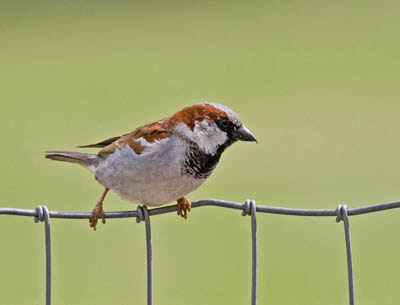 |
| House Sparrow. Greg Gillson. |
Found throughout much of Canada and the United States, wherever there are people and towns.
House Sparrows are year-round residents throughout Maryland.
Small squatty flat-headed sparrows. Females are rather brown and tan with a pale broad eyebrow, and plain breast without streaking. Males are more chestnut brown above with white wing bars, gray below, with gray crown and black chin, more extensive in summer.
House Sparrows eat a wide variety of small seeds and human food scraps from hopper and platform feeders, and also the ground.
Setting up a winter bird feeding station in Maryland
Because the three most common winter birds at feeders in Maryland are Northern Cardinal, White-throated Sparrows, and Carolina Chickadees, I recommend a mixed bird seed.
Don’t buy the cheap stuff, however. That contains a lot of red milo and other seeds that wild birds don’t like.
The Songbird Supreme mix that I prefer contains 50% sunflower seeds: black oil, striped, and hulled. The chickadees, House Finches, titmouses, and White-breasted Nuthatches really love these. I mix this Songbird Supreme seed together with black oil sunflower seed half and half, which yields about 75% sunflower seeds!
The other main ingredient is white proso millet, which is a favorite of the White-throated Sparrows and other sparrows and juncos.
It also has a few peanuts that jays and nuthatches love.
I’d put these in a hopper feeder with a wide roof to keep out the rain and snow. Check out my article below on different kinds of bird feeders.
A second tube feeder should be filled with black oil sunflower seeds. This vertical feeder keeps out water better. As an added benefit, it is hard for large birds like starlings and jays to perch upon. So it helps deter these sometimes “pest” or “bully” birds.
Tube feeders with black oil sunflower seeds are a favorite of American Goldfinches, House Finches, and Carolina Chickadees.
Finally, I would set up a suet feeder.
A year ago I bought a Nature’s Way upside-down suet feeder. It’s simple, but effective. The woodpeckers and small birds like chickadees and Carolina Wrens have no trouble eating from it. But the jays and starlings have a terrible time. That’s good, because a couple of jays or starlings or grackles will eat an entire block of suet in short order.
I like the St. Alban’s Bay suet. You may find other suet that birds like better, but this gives you a low price to compare. Half the packages are peanut, half are berry. I haven’t noticed that the birds like either one better than the other.
Suet is primarily a winter food. It can melt or go rancid in summer heat. And the birds that like suet prefer real insects for protein and fat when they are available in summer.
You may also consider a bird bath heater to provide drinking water during frozen periods of Maryland’s severe winters. Birds need to drink water several times a day–even in winter.
Wrapping Up
It is usually the small birds that concern us the most in the winter months. But they are actually masters of surviving harsh conditions! They employ a fascinating array of adaptations, behaviors, and physiological tricks to keep the chill at bay and make it through even the frostier months. Here’s a peek into their winter survival toolkit:
Keeping Warm Inside and Outwardly Dressed for Success:
Their plumage acts like a downy jacket, trapping layers of air to create insulation against the cold. The muscle activity caused by shivering generates heat, providing an internal furnace on demand.
Being small becomes an advantage as it means less surface area to lose heat, giving them an advantage in colder temperatures. And, of course, they increase their body fat percentage before winter, acting as an energy reserve and additional insulation.
Fueling the Internal Furnace:
Their tiny bodies burn food incredibly fast, generating heat to stay warm and they also switch to foods rich in fats and oils, like seeds, nuts, and suet, providing concentrated energy.
Small birds focus on sheltered areas and sunny patches to minimize energy expenditure during food finding. Some species will huddle together to share body heat, especially at night.
Finding Shelter from the Blizzard:
Many birds utilize natural cavities and nest boxes for protection from wind and snow. Dense foliage also provides them with windbreaks and insulation from the elements.
They stay closer to the ground, where there’s less wind chill and potentially warmer pockets of air and some species, like chickadees, adjust their roosting position throughout the night to maximize heat retention.
Frequently Asked Questions
Do goldfinches stay in Maryland in winter?
The American Goldfinch are the most common bird in Maryland and often do stay year-round, though their numbers may decline in winter as some individuals migrate south. They readily adapt to winter conditions by feasting on seeds, especially thistle, and utilizing sheltered areas.
What is the gray bird in Maryland?
The Gray Catbird is resident in Maryland but may not stay all year round depending on the specific location and individual bird.
Gray Catbirds breed throughout the eastern United States, including Maryland. Birds from the northernmost parts of their breeding range, like northern Maryland, typically migrate south for the winter to the southern United States or Central America.
Birds from the southernmost parts of their breeding range, like southern Maryland, may sometimes stay year-round if food and shelter are plentiful and temperatures remain mild.
Factors influencing winter stay:
- Food availability: Abundant berries, fruits, and insects can encourage some catbirds to stay through the winter.
- Habitat: Dense woodlands and sheltered areas provide protection from harsh weather and predators.
- Temperatures: Milder winters with less snow and ice can make Maryland more hospitable for overwintering catbirds.
Observations in Maryland:
- Studies suggest that around 50% of gray catbirds in Maryland migrate south, while the remaining population stays year-round.
- Sightings of gray catbirds in Maryland during winter are more common along the coast and in milder southern regions.
Where are some birding hotspots in winter Maryland?
Winter in Maryland doesn’t mean a break from birding! Though some familiar faces have flown south, the state still offers exciting opportunities to see stunning feathered residents and unexpected winter visitors. Here are some top birding hotspots in Maryland you should explore during the colder months:
Eastern Shore:
- Blackwater National Wildlife Refuge: This vast refuge is a paradise for winter waterfowl, hosting tens of thousands of ducks, geese, swans, and bald eagles. Hike the Wildlife Drive or visit the Fisherman’s Park observation platform for breathtaking sights.
- Deal Island Wildlife Management Area: Explore freshwater ponds and salt marshes teeming with winter sparrows like white-throated, song, and swamp sparrows. Keep an eye out for raptors like northern harriers and rough-legged hawks hunting over the open fields.
- Eastern Neck Island National Wildlife Refuge: This barrier island sanctuary attracts various shorebirds like dunlins, sanderlings, and black-bellied plovers, along with wintering ducks and gulls. Explore the beaches and mudflats for a diverse range of coastal birds.
Central Maryland:
- Patuxent River Park: Hike along the river trails and spot wintering waterbirds like loons, grebes, and cormorants. The marshes also attract bald eagles and osprey searching for prey.
- Pickering Creek Audubon Center: This working farm and wildlife sanctuary offers diverse habitats for winter birds. Explore the Wetland Overlook Trail for a chance to see white-throated sparrows, yellow-bellied sapsuckers, and eastern bluebirds.
- Rock Creek Park: Escape the city and immerse yourself in this expansive park. Look for downy woodpeckers, chickadees, and white-breasted nuthatches foraging in the wooded areas. You might even spot a red-tailed hawk soaring overhead.
Western Maryland:
- Savage River State Forest: This scenic forest offers excellent opportunities to see wintering raptors like red-shouldered hawks and Cooper’s hawks. Deer Creek Reservoir attracts waterfowl and loons, while the forested trails shelter wintering songbirds like Carolina wrens and tufted titmice.
- Garrett County: Experience a different winter with snow-covered mountain peaks and frozen waterways. Hemlock and maple forests harbor wintering black-capped chickadees, red-breasted nuthatches, and the occasional pine siskin. Look for bald eagles along the Potomac River in this majestic part of Maryland.
Related Articles:
The most common backyard birds in Maryland
My recommended bird feeder setup
Different kinds of bird feeders for different birds
Bird baths that birds actually use







